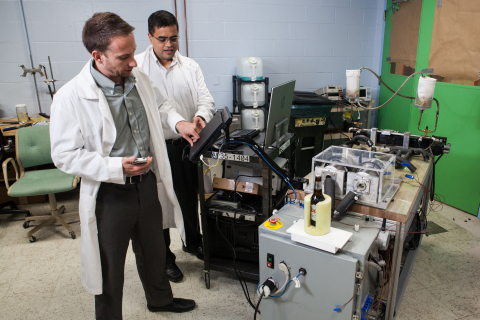LOUISVILLE, Ky.--(BUSINESS WIRE)--For the past 100 years, the way your fridge preserved your food has been rooted in technology dating back to the mid-1800s, but that is about to change. GE (NYSE:GE) researchers are developing the next leap in home refrigeration technology—magnetic refrigeration (magnetocaloric refrigeration). The technology uses no refrigerants or compressors and is 20 percent more efficient than what is used today. In addition, the technology can be applied to other heat pump applications such as HVAC and has the potential to impact nearly 60 percent of the average U.S. household’s energy consumption.*
The Past 100 Years
Ice was the primary means of residential cold storage until advances in vapor compression technology sparked the first refrigeration revolution. GE launched its first electric refrigerator in 1927. Within four years, GE built 1 million electric refrigerators, and vapor compression became the industry standard. While the technology made steady progress over time, its efficiency threshold is approaching.
“We’ve spent the past 100 years making the current technology more efficient, but most of the major efficiency increases have been achieved,” explained Venkat Venkatakrishnan, director of advanced technologies for GE Appliances.
Rise of Magnetic Refrigeration
Although magnetocaloric cooling as a concept has been around for many years, in 2006, GE began exploring the technology for home refrigeration. A team of GE researchers started from scratch to show the technology could be applied to the real world of household refrigeration and still work efficiently. After five years of analysis and testing, they were able to achieve the desired cooling effect.
How It Works
The system uses a water-based fluid rather than a chemical refrigerant such as Freon to transfer heat from inside the refrigerator and achieve the cooling process. Instead of a compressor, magnets are used to create a magnetic field that agitates particles in the fluid causing it to cool. The strength of the magnetic fields determines how cold the fluid becomes, and in turn, how quickly it cools the refrigerator.
Today, the team’s research is progressing rapidly, and is on track to move from the lab to residential homes within the next five years. “We figured out how to create heat or cold without a compressor or chemical refrigerants,” Venkatakrishnan said. “This breakthrough can power your fridge with greater efficiency, and because the technology does not contain traditional refrigerants, recycling refrigerators at end of life will be easier and less costly. GE is leading the development of the next refrigeration revolution.”
In addition to the work GE Appliances’ engineers are doing, GE Global Research and Oak Ridge National Laboratory (ORNL) are also working on the development. GE Global Research is using its materials expertise to work on developing new alloys as well as help with modeling and thermodynamics. ORNL is funded by the U.S. Department of Energy to work in conjunction with GE to assess specific component and material requirements for stable and reliable operation of the refrigerator-freezer, evaluate magnetocaloric effect materials, and maximize the performance of the refrigerator-freezer in laboratory testing. For more information about the U.S. Department of Energy Building Technologies Office, visit energy.gov/eere/buildings/building-technologies-office.
About GE Appliances
GE Appliances is at the forefront of building innovative, energy-efficient appliances that improve people’s lives. GE Appliances’ products include refrigerators, freezers, cooking products, dishwashers, washers, dryers, air conditioners, water filtration systems and water heaters. General Electric (NYSE:GE) works on things that matter to build a world that works better. For more information on GE Appliances, visit www.ge.com/appliances.
About GE Global Research
GE Global Research is the hub of technology development for all of GE's businesses. Our scientists and engineers redefine what’s possible, drive growth for our businesses, and find answers to some of the world’s toughest problems. We innovate 24 hours a day, with sites in Niskayuna, New York; San Ramon, California; Bangalore, India; Shanghai, China; Munich, Germany; and Rio de Janeiro, Brazil.
About Oak Ridge National Laboratory
Oak Ridge National Laboratory is DOE’s largest multi-program science and energy laboratory, with scientific and technical capabilities spanning the continuum from basic to applied research. These resources enable the lab to tackle an exceptionally wide range of R&D assignments, from fundamental nuclear physics to applied R&D on advanced energy systems. ORNL aggressively pursues opportunities to put solutions to work, often collaborating with industry to accelerate their deployment by the private sector. Products as diverse as radiation detectors, thin-film batteries, high-efficiency heat pumps, and high-performance steel alloys have emerged from the lab’s R&D. For more information about ORNL, visit www.ornl.gov/.
*Source: U.S. Energy Information Administration’s annual energy outlook for the residential sector.




